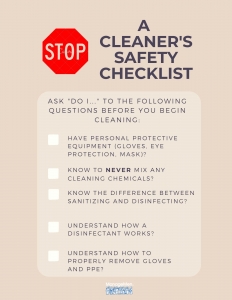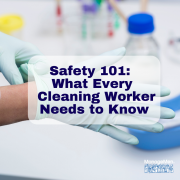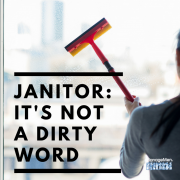Protecting Custodial Workers: What Every New Cleaning Worker Needs to Know
Long before COVID-19 infected patient zero, a large percentage of the 3.25 million cleaning workers in the U.S. received little job training. In some circles, the assumption is that most people know how to clean, so the absence of training might not seem like a big deal. Individuals in these groups treat it as an inherent skillset that people are either born with or learn at an early age.
But the thing is, not everyone just “knows” how to clean. As a recent survey showed, the majority of Americans aren’t disinfecting properly. And the processes you would use to clean a building are different than how you would clean your home or apartment.
There are many issues with the lack of occupational training in the cleaning industry, but a primary issues is the increased risk and exposure to workers. Data from the Bureau of Labor Statistics shows that cleaning workers suffer the second highest rates of job-related injuries of any occupation—injuries heavy lifting, overexertion, chemical exposure and slips and falls are most common.
Reducing Risks to Cleaning Workers Now and After the Pandemic
When it comes to COVID-19, cleaning and disinfection is essential in stopping the spread of the disease. Aside from person-to-person spread, COVID-19 spreads when a person comes into contact with contaminated surfaces or objects. So when businesses slowly begin to open again over the next few months, all eyes will be on cleaning workers. Regular, systematic cleaning and disinfection will be key to controlling the spread of the virus and limiting the additional waves of the pandemic.
For these individuals to clean—and to not pollute the surfaces and buildings they are meant to protect—they need training. They also need training to protect themselves.
During this period, we can expect to see a swell of new cleaning service providers. Many people who have been displaced from current jobs in the hospitality or foodservice industries may find themselves working in a position where they’re being asked to clean in a commercial environment for the first time.

We’ve seen way too many headlines highlighting cleaning workers who are concerned because they don’t understand the routes of transmission or how they could become infected. Too many people who are asked to use new disinfectants and don’t have training to do so. Too many people who aren’t equipped with the right personal protective equipment (PPE) to protect their hands and faces from exposure.
We need to reverse this trend and make sure ALL cleaning workers have the knowledge and training they need to clean safely and protect themselves.
If you’re new to cleaning, we’ve pulled together a checklist of things you should know before you start working.
This is not meant to replace any existing training programs, but rather serve as a supplement. Our hope is to help provide a resource for those individuals who may not receive any training from their employers. If that’s you, we’re here for you. Please feel free to reach out with any questions about what you can do to protect yourself during this time.




